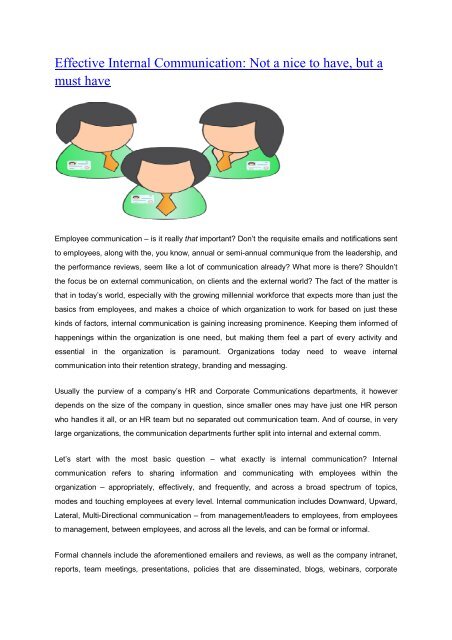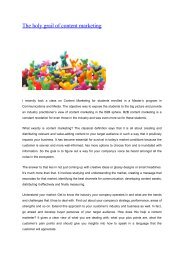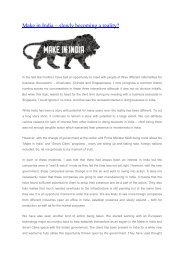Effective Internal Communication Not a nice to have, but a must have
Employee communication – is it really that important? Don’t the requisite emails and notifications sent to employees, along with the, you know, annual or semi-annual communique from the leadership, and the performance reviews, seem like a lot of communication already?
Employee communication – is it really that important? Don’t the requisite emails and notifications sent to employees, along with the, you know, annual or semi-annual communique from the leadership, and the performance reviews, seem like a lot of communication already?
You also want an ePaper? Increase the reach of your titles
YUMPU automatically turns print PDFs into web optimized ePapers that Google loves.
<strong>Effective</strong> <strong>Internal</strong> <strong>Communication</strong>: <strong>Not</strong> a <strong>nice</strong> <strong>to</strong> <strong>have</strong>, <strong>but</strong> a<br />
<strong>must</strong> <strong>have</strong><br />
Employee communication – is it really that important? Don’t the requisite emails and notifications sent<br />
<strong>to</strong> employees, along with the, you know, annual or semi-annual communique from the leadership, and<br />
the performance reviews, seem like a lot of communication already? What more is there? Shouldn’t<br />
the focus be on external communication, on clients and the external world? The fact of the matter is<br />
that in <strong>to</strong>day’s world, especially with the growing millennial workforce that expects more than just the<br />
basics from employees, and makes a choice of which organization <strong>to</strong> work for based on just these<br />
kinds of fac<strong>to</strong>rs, internal communication is gaining increasing prominence. Keeping them informed of<br />
happenings within the organization is one need, <strong>but</strong> making them feel a part of every activity and<br />
essential in the organization is paramount. Organizations <strong>to</strong>day need <strong>to</strong> weave internal<br />
communication in<strong>to</strong> their retention strategy, branding and messaging.<br />
Usually the purview of a company’s HR and Corporate <strong>Communication</strong>s departments, it however<br />
depends on the size of the company in question, since smaller ones may <strong>have</strong> just one HR person<br />
who handles it all, or an HR team <strong>but</strong> no separated out communication team. And of course, in very<br />
large organizations, the communication departments further split in<strong>to</strong> internal and external comm.<br />
Let’s start with the most basic question – what exactly is internal communication? <strong>Internal</strong><br />
communication refers <strong>to</strong> sharing information and communicating with employees within the<br />
organization – appropriately, effectively, and frequently, and across a broad spectrum of <strong>to</strong>pics,<br />
modes and <strong>to</strong>uching employees at every level. <strong>Internal</strong> communication includes Downward, Upward,<br />
Lateral, Multi-Directional communication – from management/leaders <strong>to</strong> employees, from employees<br />
<strong>to</strong> management, between employees, and across all the levels, and can be formal or informal.<br />
Formal channels include the aforementioned emailers and reviews, as well as the company intranet,<br />
reports, team meetings, presentations, policies that are disseminated, blogs, webinars, corporate
videos, resource libraries – the list is endless – can you think of some more? Informal communication<br />
is more often than not verbal, and includes games and activities watercooler conversations, the<br />
infamous “grapevine” and any casual conversation with a colleague or even your boss – you know,<br />
the “off the record” kind. Sometimes, information that would otherwise not <strong>have</strong> reached you comes<br />
your way as a result of this informal communication.<br />
Food for thought: What do Social Media channels fall under?<br />
As I write this, I am realizing that social media is fast becoming another medium of<br />
communication – from Facebook and Twitter <strong>to</strong> LinkedIn and Yammer or its equivalent. Where<br />
do these channels fall, I wonder? Are the formal, informal or somewhere in between, straddling<br />
the line? LinkedIn is seen as a professional networking site, and thus would probably get<br />
categorized as formal. But what about say an Instagram pho<strong>to</strong> of an office party, or even a selfie<br />
taken at work? Tweets and FB posts are often in the form of a shared article or car<strong>to</strong>on – is there<br />
some formal, thought out communication taking place or are they just an informal reaching out?<br />
As I ponder this, do head <strong>to</strong> the comments and share your perspective.<br />
So, the next question then is, why should one expend effort and put time and thought in<strong>to</strong> internal<br />
communication? Well, it has quite a widespread effect, actually. <strong>Effective</strong> internal communication is<br />
vital <strong>to</strong> employee engagement and morale and ultimately leads <strong>to</strong> motivation, productivity, loyalty, and<br />
has an impact on retention rates. It leaves employees with a sense of belonging, of purpose, of<br />
feeling important and vital <strong>to</strong> the organization. And this directly correlates <strong>to</strong> employee satisfaction<br />
rates. Employee buy-in increases and that affects performance as well, when they feel cared for.<br />
One of our recent clients at Prayag, one of the “big five” in the accounting world, is a prime example<br />
of a company that takes its internal communication very seriously – and it shows in multiple ways. For<br />
one, they <strong>have</strong> a dedicated team internally. Then they decided that they wanted <strong>to</strong> work with an<br />
agency <strong>to</strong> help with ideation and execution of their internal communication campaigns, which, by the<br />
way, are a calendarized, well thought out and planned in advance set of endeavors. They are always<br />
on the lookout for innovative and interesting ways <strong>to</strong> share information and communicate with the<br />
employee base – be it introducing new recruits, announcing annual results, a CSR event, or anything<br />
else. After spending a week at their offices for induction, I came back struck by the enthusiasm,<br />
dedication, and high levels of motivation of the employees I met. And I think it is safe <strong>to</strong> say that one<br />
of the reasons for the willingness <strong>to</strong> log in at late hours, take meetings from home and be available, is<br />
the company’s culture, strong communication with and support for, employees. Also see more info @<br />
http://www.prayag.com/blogs

















